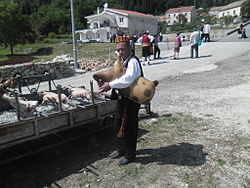Diple: Difference between revisions
m Reflist |
it is not traditional musical instrument in Serbian music, we need RS which confirms this, it is a traditional instrument from Istria to Montenegro including part of Bosnia and Herzegovina, |
||
| Line 31: | Line 31: | ||
* [[Volynka]] ({{lang-uk|Волинка}}), ({{lang-ru|Волынка}}) ([[Ukraine]], [[Russia]]) |
* [[Volynka]] ({{lang-uk|Волинка}}), ({{lang-ru|Волынка}}) ([[Ukraine]], [[Russia]]) |
||
}} |
}} |
||
'''Diple''', '''dvojnice''', or '''dvojanke''' ([[pluralia tantum]]; pronounced {{IPA-sh|dîple̞|}}, {{IPA-sh|dʋǒ̞ːjnit͡se|}} and {{IPA-sh|dʋǒ̞jaːŋke̞|}}) is a traditional [[woodwind]] musical instrument in |
'''Diple''', '''dvojnice''', or '''dvojanke''' ([[pluralia tantum]]; pronounced {{IPA-sh|dîple̞|}}, {{IPA-sh|dʋǒ̞ːjnit͡se|}} and {{IPA-sh|dʋǒ̞jaːŋke̞|}}) is a traditional [[woodwind]] musical instrument in [[Croatian music|Croatian]] and [[Montenegrin music]]. |
||
==The flute== |
==The flute== |
||
Revision as of 07:45, 19 May 2020
 | |
| Classification | |
|---|---|
| Related instruments | |
| |
Diple, dvojnice, or dvojanke (pluralia tantum; pronounced [dîple̞], [dʋǒ̞ːjnit͡se] and [dʋǒ̞jaːŋke̞]) is a traditional woodwind musical instrument in Croatian and Montenegrin music.
The flute
The diple, or dvojnice, may be found as a fipple flute or as a reedpipe, but in either case is distinctive in that it incorporates two bores within one body, and thus creates two notes simultaneously. Generally, the left hand fingers a group of holes on the left side of the body, and the right on its side.
Droneless bagpipes
All bagpipe diple have a double chanter with two separate single reeds and they originate in Montenegro, Bosnia and Herzegovina and Dalmatia where they differ among themselves.[1] The bag of the bagpipes is called a meh, which consists of a tanned goat skin, the blowpipe is a dulac or gajdenica, through which the air is blown, which is in fact a double chanter used to play the melody and harmony simultaneously. The chanter incorporates two single reeds, one in each bore. The meh is played from Istria to Dalmatia and in Lika, Dalmatian Hinterland and Herzegovina.[2]
Unlike the majority of European bagpipes, the meh has no drone (trubanj, prdalo, prdaljka), instead playing both a melody and harmony part on the chanter. Though their general form is similar, the meh in different parts of Bosnia varies in chanter tunings, ornamentation, and other small factors. The meh is an untempered instrument, and its specific intonation varies by region.
References
- ^ Zagorka Marković, 1987, Narodni muzički instrumenti,https://books.google.com.bz/books?id=7i44AAAAMAAJ&printsec=frontcover#v=onepage&q&f=false #page=74-76
- ^ Marijana Dlačić, Hrvoje Badurina, Tajna melodija ovčje kože, 2012, http://muzejovcarstva.org/wp-content/uploads/2017/07/MIH.pdf#page=18
External links
